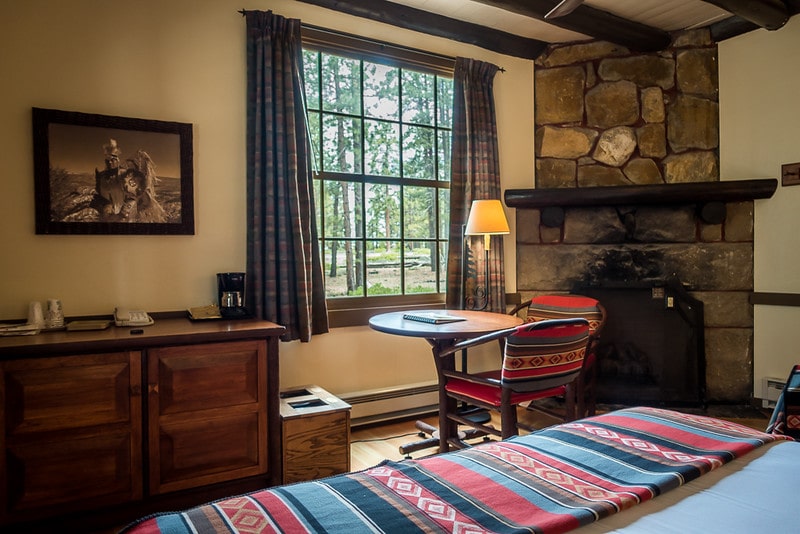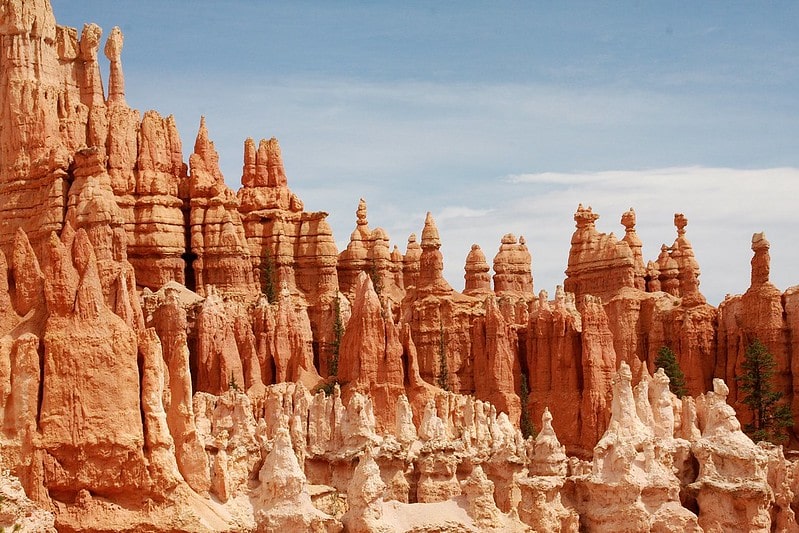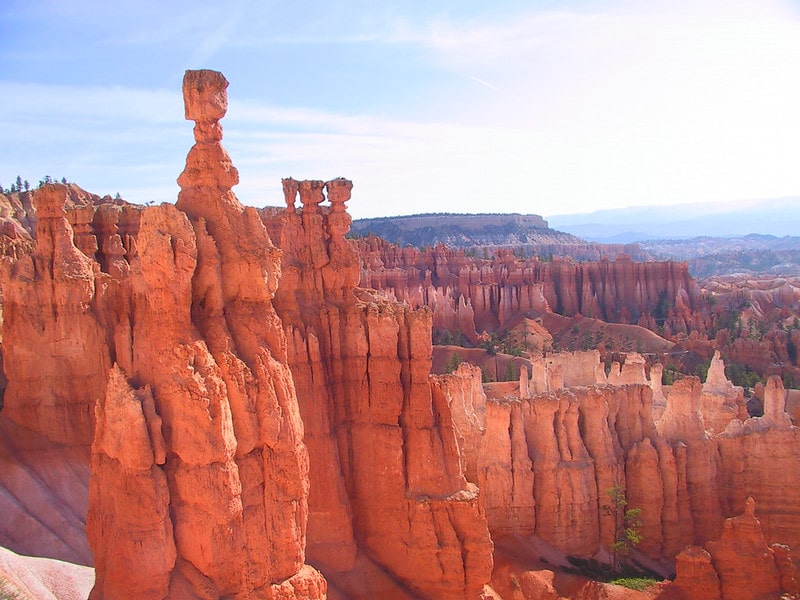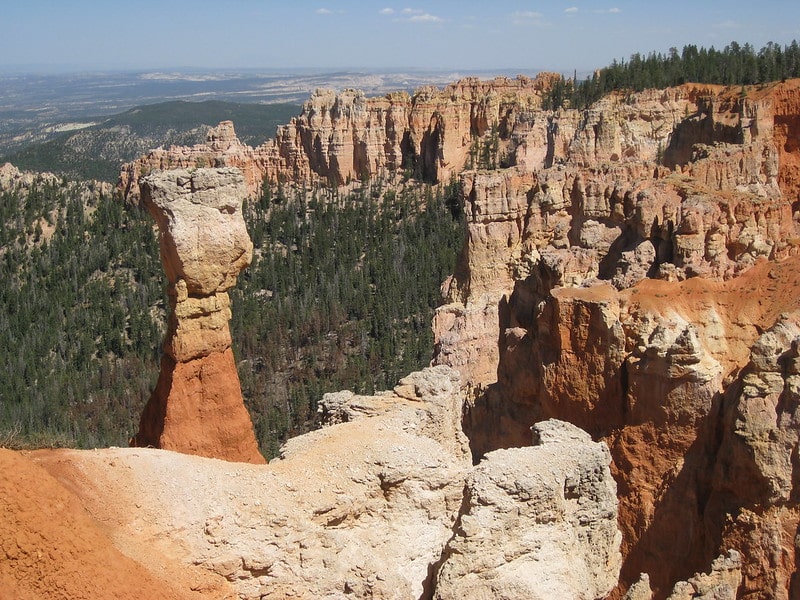Last updated on July 7th, 2021
1. Bryce Canyon National Park is one of the most popular parks in southwestern Utah, U.S.A. It was established in 1923 to preserve its beauty and scientific importance. It has an area of 35,835 acres or 145 sq. km. and receives over 2.5 million visitors each year.
2. Although it is named Bryce Canyon, the geographic feature is not actually a canyon. Instead, it is a group of natural formations known as amphitheaters found on the eastern side of the Paunsaugunt Plateau.
3. Bryce Canyon was named after a Mormon pioneer, Ebenezer Bryce. Bryce and his family settled and helped build the first church in the area near Bryce Canyon in 1875. The Church of the Latter Day Saints later asked the Bryce family to settle Paria Valley, which is south of the canyon. Their travel paved the way to what would become a national park.
4. According to legend, the canyon was named after Bryce because he found the area a “hell of a place” to raise cattle. His cows would often wander and become lost in the rock formations that formed the canyon. It was originally known as Bryce’s canyon and later formalized as Bryce Canyon.
5. The area surrounding Bryce Canyon was designated by Pres. Warren Harding as a national monument in 1923. The U.S. Congress later designated it as a national park.
6. The decision to turn Bryce Canyon into a national park was prompted by the damage that was done by logging, overgrazing, and unregulated tours to the site. The National Park Service is now the administrator of the park.
7. Three groups of people are responsible for the rich history surrounding Bryce Canyon. These are the Anasazi, the Paiute, and the Fremont. They were known to use this area prior to the arrival of the settlers. They did not live there, though, because of the harsh winter that the area typically experiences.
8. Bryce Canyon was actually established first as a national monument in 1923. The next year, it underwent a name change and became Utah National Park. Three years later, with land area expanded due to the acquisition of more land by the federal government, its name was changed again to national park.
9. Bryce Canyon is not as popular to visitors as the Grand Canyon or Zion national parks because it is more remote. However, it is close to Zion National Park and can be accessed by car via a 2.5-hour drive.
10. Bryce Canyon is located in a high desert area but due to its altitude that ranges from 4,000 to 11,000 feet, certain areas make it possible for coniferous forests and alpine meadows to thrive. These plants serve as haven and habitats for numerous flora and fauna.
11. The park hosts the Bryce Canyon Astronomy Festival, usually in June. Thousands often flock to the park to participate in the various programs and activities the park holds in partnership with local astronomical societies and the park’s own Astronomy Rangers.
12. Some of the first promotional materials for the park were published in 1916 by railroad magazines. This, along with enterprising individuals who provided tour services, helped increase the number of visitors to the park. By the 1920s, Union Pacific Railroad began considering expanding their services to the region to cater to the tourists.

13. The oldest accommodation built for Bryce Canyon tourists is the venerated Bryce Canyon Lodge, or simply, The Lodge. It was built beginning in 1924 and completed in 1925 using local stone and timber. It still stands today and remains operational.
14. Bryce Canyon has 3 life zones due to the differences in its elevation. These are the Pinyon, the Ponderosa, and the spruce/fir forest.
15. The temperatures within the park vary from −13 °C to 28 °C. However, extreme weather can bring down the temperature to −34 °C or raise it to as high as 36 °C. Visitors are reminded to ensure that they are fully protected and aware of their surroundings.
16. Bryce Canyon has the world’s largest collection of a specific rock formation called hoodoos. These are rock spires that formed due to erosion caused by rainwater. Thousands of years of this action has created a stunning maze-like formation of multi-colored wonder.

17. According to Native American legend, the hoodoos were once human. They were known as To-when-an-ung-wa or Legend People who are actually birds, lizards, or animals. They simply shapeshifted as humans. They were supposedly bad and were punished by Coyote, the god of mischief, who turned them into rocks.
18. Native Americans refer to the area as Angka-ku-wass-a-wits, which means red-painted faces. Supposedly, if one looked closer at the red rocks, the faces of the people who became stone could be seen.
19. The rocks found at Bryce Canyon are estimated to be at least 65 million years old. However, experts believe they are very young – the youngest, actually – on the Colorado Plateau.
20. Bryce Canyon is the smallest national park in Utah. It is also the 12th smallest in the United States.

21. Because of its natural landscape, Bryce Canyon did not likely attract inhabitants, even in the past. Winters here are especially harsh. However, prehistoric people may have used it to hunt and scavenge for food.
22. Its elevation makes Bryce Canyon a natural viewing deck. On days when weather is excellent, the view is so clear that it is possible to see at least 100 miles into the distance.
23. Thor’s Hammer is one of the park’s most famous landmarks. This massive rock formation is 150 feet tall. At its crest is a large sandstone block resembling the Norse god’s weapon. The shape is the result of erosion and the type of material that make up the hoodoo. The top portion is harder while the lower area is softer and easily eroded.

24. The Hunter is another popular hoodoo in Bryce Canyon. It is found at Agua Canyon and located beside a smaller formation known as The Rabbit. Erosion has changed the structures, so one has to look very hard to see the resemblance today.
25. The hoodoos in the park range in height from under 6 feet to over 200 feet. The term “hoodoo” to refer to the rock formations is appropriate because the word means to bewitch.
26. Bryce Canyon was not an overnight success as far as national parks go. Tourists found it difficult to access the park and largely stayed away. In 1920, volunteers worked on the dirt road that led from Panguitch to Bryce through the Red Canyon to smooth it out so tourists could visit.
27. For about 10 years after its opening as a park, Bryce Canyon was only accessible from the northwest rim which is likely where Sunrise Point begins. From there, tourists could either walk or travel by horse. Today, it is possible to enjoy the park by car or by shuttle bus.
28. Bryce Canyon has four main viewpoints – Sunrise, Sunset, Inspiration, and Bryce. There are, of course, other viewpoints but these are considered the best in terms of the views they offer.
29. The NPS (National Park Service), oversees America’s national parks. Parks that collect fees such as Bryce Canyon, get to keep 80% of the fees, while the NPS collects the remaining 20% to benefit other parks that do not charge entrance fees.
30. Bryce Canyon can be enjoyed without leaving the car. The Scenic Drive consists of a 38-mile round-trip drive that lets visitors access 13 viewpoints along the popular route. The drive lasts about 2 hours to about half a day.
31. The primary type of erosion that formed Bryce Canyon is known as frost wedging. When rainwater or melting snow seeps into the rock crevices and low temperature hits, the water freezes, causing the rocks to break apart.
32. The rock layer found in Bryce Canyon was likely covered by an ancient lake 30 to 40 million years ago. The red, pink, white, and orange colors on the rocks at different heights are the result of mineral deposits.
33. Two hundred days out of every year, Bryce Canyon experiences extreme temperatures that create the ideal conditions for hoodoos to form. The shape of these hoodoos continue to change as the years pass.
34. Bryce Canyon is home to over 400 (some sources say about a thousand) species of plants. It has 59 mammal species, at least 45 moth and butterfly species, more than 100 bird species, and plenty of reptile species. The exact number of insect species it protects is still unclear but believed to be at the minimum, a thousand.

35. One of the park’s longtime residents is the Great Basin Rattlesnake. This is a highly adaptable reptile, often found on rocky outcrops and slopes, or near prairie dog habitats. Although it is not unique to Bryce Canyon, this rattlesnake is the only venomous snake species found in the park.
. . . continue reading on the next page
